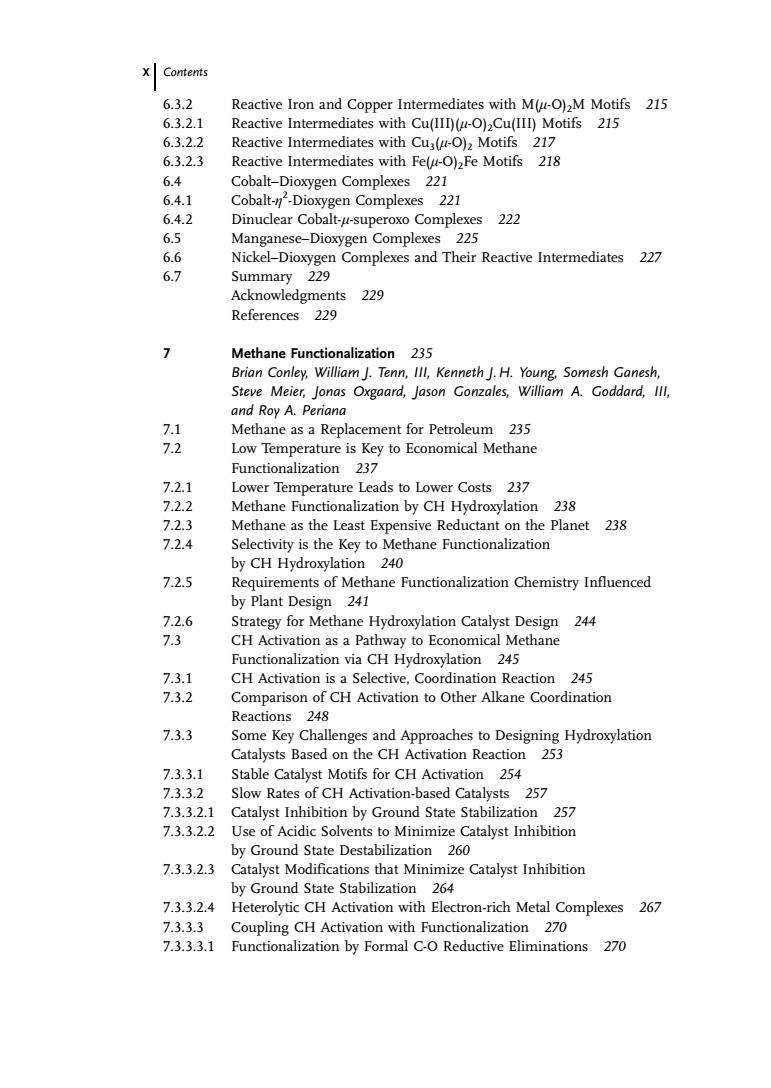正在加载图片...

x Contents 6.3.2 Reactive Iron and Copper Intermediates with M(u-O)M Motifs 215 6321 Reactive Intermediates with Cu(III)(u-O)Cu(III)Motifs 215 6.3.2.2 Reactive Intermediates with Cus(u-O),Motifs 217 6.3.2.3 Reactive Intermediates with Felu-O)Fe Motifs 218 221 021 -superoxo Co 222 xygen Complex -Dioxygen Complexes and Their Reactive Intermediates 227 Summary 229 Acknowledgments 229 References 229 Methane Functionalization 235 Brian Conley,William J.Tenn,Ill,Kenneth J.H.Young,Somesh Ganesh, Steve Meier,Jonas Oxgaard,Jason Gonzales,William A.Goddard,Ill., and Roy a Periana 7.1 Methane as a replac ment for Petroleum 235 7.2 Low Temperature is key to economical methane Functionalization 237 Ter eads to Lower Costs 237 ion by CH 238 thane as the Least E ant on the Planet 238 ethane Functional 7.2.5 Requirements of Methane Functionalization Chemistry Influenced by Plant Design 241 7.2.6 Strategy for Methane Hydroxylation Catalyst Design 244 7.3 CH Activation as a Pathway to Economical Methane Functionalization via CH Hydroxylation 245 7.3.1 CH Activation is a Selective,Coordination Reaction 245 732 Comparison of CH Activation to Other Alkane Coordination Reactions 248 7.3.3 Some key challenges and approaches to designing hydroxvlation Catalysts based on the cH activation reaction 253 on 254 Rat of CH Activatio 257 st e of A vents Minimize Catalyst Inh or by Ground State Destabilizat on <60 7.3.32.3 Catalyst Modifications that Minimize Catalyst Inhibition by Ground State Stabilization <64 7.3.32.4 Heterolytic CH Activation with Electron-rich Metal Complexes 267 7.3.3.3 Coupling CH Activation with Functionalization 270 7.3.3.3.1 Functionalization by Formal C-O Reductive Eliminations 270 6.3.2 Reactive Iron and Copper Intermediates with M(-O)2M Motifs 215 6.3.2.1 Reactive Intermediates with Cu(III)(-O)2Cu(III) Motifs 215 6.3.2.2 Reactive Intermediates with Cu3(-O)2 Motifs 217 6.3.2.3 Reactive Intermediates with Fe(-O)2Fe Motifs 218 6.4 Cobalt–Dioxygen Complexes 221 6.4.1 Cobalt-2 -Dioxygen Complexes 221 6.4.2 Dinuclear Cobalt--superoxo Complexes 222 6.5 Manganese–Dioxygen Complexes 225 6.6 Nickel–Dioxygen Complexes and Their Reactive Intermediates 227 6.7 Summary 229 Acknowledgments 229 References 229 7 Methane Functionalization 235 Brian Conley, William J. Tenn, III, Kenneth J.H. Young, Somesh Ganesh, Steve Meier, Jonas Oxgaard, Jason Gonzales, William A. Goddard, III, and Roy A. Periana 7.1 Methane as a Replacement for Petroleum 235 7.2 Low Temperature is Key to Economical Methane Functionalization 237 7.2.1 Lower Temperature Leads to Lower Costs 237 7.2.2 Methane Functionalization by CH Hydroxylation 238 7.2.3 Methane as the Least Expensive Reductant on the Planet 238 7.2.4 Selectivity is the Key to Methane Functionalization by CH Hydroxylation 240 7.2.5 Requirements of Methane Functionalization Chemistry Influenced by Plant Design 241 7.2.6 Strategy for Methane Hydroxylation Catalyst Design 244 7.3 CH Activation as a Pathway to Economical Methane Functionalization via CH Hydroxylation 245 7.3.1 CH Activation is a Selective, Coordination Reaction 245 7.3.2 Comparison of CH Activation to Other Alkane Coordination Reactions 248 7.3.3 Some Key Challenges and Approaches to Designing Hydroxylation Catalysts Based on the CH Activation Reaction 253 7.3.3.1 Stable Catalyst Motifs for CH Activation 254 7.3.3.2 Slow Rates of CH Activation-based Catalysts 257 7.3.3.2.1 Catalyst Inhibition by Ground State Stabilization 257 7.3.3.2.2 Use of Acidic Solvents to Minimize Catalyst Inhibition by Ground State Destabilization 260 7.3.3.2.3 Catalyst Modifications that Minimize Catalyst Inhibition by Ground State Stabilization 264 7.3.3.2.4 Heterolytic CH Activation with Electron-rich Metal Complexes 267 7.3.3.3 Coupling CH Activation with Functionalization 270 7.3.3.3.1 Functionalization by Formal C-O Reductive Eliminations 270 X Contents�����